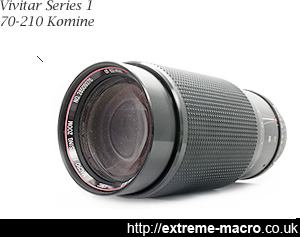Vivitar 70-210mm f2.8-4
by Johan J Ingles-Le Nobel
Last updated August 31, 2017
If you drop this lens, check your floor for damage before you check the lens
The Vivitar Series I 70-210 f/2.8 with its single focus and zoom ring is a manual classic, a big old brick of a lens dating from the 1970s.
Vivitar 70-210 is one of many lenses that we use for macro, and gives a 1:2 magnification ratio.
Series 1

The Vivitar Series I 70-210 f/2.8 with its single focus and zoom ring is a manual classic, a big old brick of a lens.
The single focus and zoom ring is definitely an acquired taste, but on the other hand does allow you to do everything in one stroke.
This is handy when you need to shoot something that will run, hop or fly away, like many things will do with a lens poked in their face
In 1975 Vivitar introduced their Series 1 line of lenses, intended to compete with top brands. These Vivitar Series 1 lenses were built to very close tolerances and evidently each lens was checked and adjusted upon entering the country of importation.
The 70-210 is probably the best remembered from this series, and sought after by bargain hunters willing to overlook the lack of autofocus in return for reasonable quality optics and construction.
There are in fact five versions of the Vivitar Series I 70-210. The first Vivitar Series 1 70-210 f3.5 was introduced in 1975 and was succeeded by the Tokina version, also 70-210 f3.5. However the Tokina version does not focus as closely as the original Kino Precision built lens.
The third (Komine) version was introduced in '84, and has 14 elements in 10 groups. This lens has a variable f/2.8-f/4 aperture, and there is a limited Pentax-specific version which has the 'A' setting.
The later two versions are allegedly of poorer optical quality and are not sought after.
Single Zoom and Focus
The single focus and zoom ring is an acquired taste single focus and zoom ring is an acquired taste, and the lens is prone to zoom creep if tilted at an angle. That said, the focus throw is beautifully buttery and very sensitive, so micro adjustment is easy. And, a single focus and zoom ring does allow you to do everything in one hand, which is handy when you need to shoot something that will run, hop or fly away, like many things will do with a lens poked in their face.
Macro Performance
The Vivitar Series I 70-210 f/2.8 is prone to lower contrast from veiling flare and shows a lot of improvement with a hood.
Beware that the lens can come up with enthusiastic purple fringing when shooting towards bright lightThe Bokeh is iffy, tending toward harsh doubling or nisen-bokeh, which is annoying with out of focus foliage.
The lens is sharp wide open toward the short end, but softer wide open toward the long end.
Beware that the lens can come up with enthusiastic purple fringing when shooting towards bright light when not stopped down, but this goes by f5.6-f/8, and is less at the long end.
Unfortunately there is significant variation within this lens when buying it used today because of user experience and how the owners have (mis)used it - buying old lenses is always a bit of a gamble.
Macro Handling
sought after by bargain hunters willing to overlook the lack of autofocus in return for reasonable quality optics and constructionThe Vivitar Series I 70-210 f/2.8 lens is heavy compared to today's digital lenses, but the actual build construction is built to last. If you drop this lens, check your floor for damage before you check the lens. It has 1:2.5 macro from 100-210mm, with a working distance of about 50cm. Good results have been reported using it with an achromat diopter.
Vivitar
Vivitar was started in the 1930s and in the 60s commissioned experienced lens designers and top-line Japanese optical lens manufacturers such as Kino Precision to produce lens designs. This gained the company a reputation for good quality lenses at modest prices, and as their reputation grew, many lens manufacturer sought them out to carry their products under the Vivitar brand. In the 1970s, Vivitar introduced its now-famous Series 1 lenses. These computer-designed state-of-the-art lenses were well priced and often outperformed the optics of camera manufacturers of the day.
After the deaths of its original founders Vivitar went to a variety of owners and on August 21, 2008, subsequent to its filing for bankruptcy, the parent company Syntax-Brillian completed the sale of the Vivitar brand name and intellectual property to privately held consumer electronics maker Sakar International based in Edison, New Jersey. Vivitar has since put out some smaller digital cameras and a tablet, but is no longer a big name in the camera industry.
Related Articles


